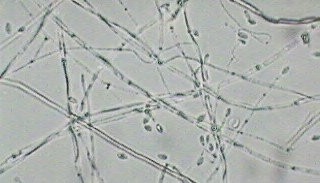
Aphanocladium species Fungus
Aphanocladium – GENUS
Highest BSL - 1
Other names - Engyodontium alba, Beauveria alba, Tritirachium alba, possibly Acrodontium, Cephalosporium-artige, and Acremonium album
FOUND: Soil, soil high salinity, soil high acidity, insect related habitat, leaf debris
INDOOR: Moist, wet conditions on drywall, paper, carpet, near insect havens
PATHOGENICITY: A pathogen to nematodes and rust fungus Pyrenochaeta lycopersici , rust fungus - Puccinia graminis - and a fungus on pea - Nectria haematococca.
COLONY: It is a small fast growing usually white cottony colony.
MICROSCOPIC: The hylar mycelium is single, reduced conidiophores with no zigzags. It is very delicate and completely colorless.
SPORE TRAP RECOGNITION: The spores are clear colorless, or small hylar round to ovoid spores. They are usually undifferentiated and grouped in a colorless, or Aspergillus/Penicillium category.
TAPE LIFT RECOGNITION: Tape lift recognition is very difficult. It will probably be grouped with Acremonium sp., Beauveria sp., or other related group. Genetic testing for absolute identification may be necessary.
DISSEMINATION: Insect, water droplets, wind, human and animal.
TOXIN PRODUCTION: Production of chitinases
OTHER: Experimental use as a biological control of nematodes and root rot fungus for tomatoes with noted success. Also an agent of biological control on wheat a rust fungus - Puccinia graminis.
Aphanocladium can cause crop loss in mushroom growing houses with high humidity, called spotting.